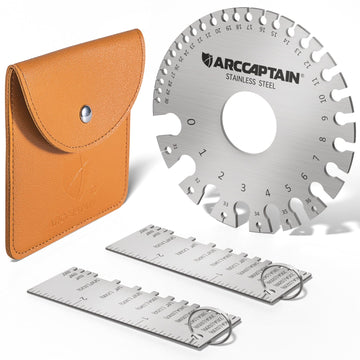Welding Measuring Tools
Welding Measuring Tools by ArcCaptain
High precision in welding is a necessity. At ArcCaptain, we understand the critical role that accuracy plays in each weld you make. That's why our collection of welding measuring tools is designed to ensure every joint, angle, and length is measured to perfection.
Dive into a range that defines reliability and finesse, crafted for professionals who demand nothing short of excellence.
Also, don't forget to explore our exclusive collections of aluminum welders, dual voltage welders, and plasma cutters here at ArcCaptain.
ArcCaptain Welding Measuring Tools: Precision Guaranteed
The difference between a good weld and a great one often comes down to the accuracy of your measurements. ArcCaptain's welding measuring tools are here to bridge that gap. We've curated a selection where each tool embodies the precision you need to execute flawless welds every time.
Welding Gauges and Calipers
Unlock a higher level of welding proficiency with our top-of-the-line gauges and calipers. Designed for ease of use and outstanding durability, these vital tools belong in the belt of every serious welder.
Traditional Welding Tools
For those who prefer a traditional touch, our analog measuring tools blend classic design with modern engineering, providing reliable and accurate measurements for any welding project.
Frequently Asked Questions
1 - What are the measuring tools used in welding?
In welding, a variety of measuring tools are vital to achieve precise and strong welds. Among them are tape measures and rulers for basic length measurements, calipers and micrometers for fine distance and thickness measurements, welding gauges to check weld sizes and shapes, angle finders for determining exact angles, and levels and plumb bobs to ensure proper alignment. Additionally, hi-lo gauges, bridge cam gauges, undercut depth gauges, and weld inspection rulers are specialized tools used to inspect various aspects of weld quality and accuracy to maintain high standards in welding projects.
2 - What instrument is used to measure weld size?
To measure weld size, welders use a tool known as a **welding gauge**. This specialized instrument comes in various designs to measure different aspects of a weld. Fillet gauges are used to measure the leg length and throat size of fillet welds, while V-weld gauges can check the size of butt welds. Other types of welding gauges can also measure the depth or height of a weld, the bevel angle of the joint, and the amount of misalignment, among other dimensions. These gauges are essential for ensuring that a weld meets the specified requirements for strength and quality.
3 - How is welding measured?
Welding measurement involves checking the size, length, and quality of a weld using specialized gauges and tools. Welders measure important aspects like the length of the weld, the size of fillet welds (known as the leg size), throat thickness, and depth of penetration to ensure the weld penetrates deeply enough for strength. They also assess the weld's angle, alignment, and profile to verify that it's shaped correctly and positioned accurately. Undercut depth gauges are used to make sure there's no excessive grooving at the weld edges which could weaken the joint. These measurements are vital for creating strong, reliable welds that meet required standards.
4 - How do you measure arc length in welding?
Measuring arc length in welding is typically done by eye and is a skill developed with practice. The welder estimates the ideal arc length based on the diameter of the electrode used—for instance, an arc length equal to the diameter of a 1/8 inch electrode would be 1/8 inch. During the welding process, the welder maintains this distance visually and adjusts as needed to accommodate for the electrode's gradual consumption. Some advanced welding machines feature electronic controls that assist in maintaining a constant arc length automatically.
5 - How do you read weld size?
To read weld size, you typically use a fillet weld gauge for fillet welds. Clean the weld, then position the gauge against the joint and slide it until you find a notch or marking that matches the weld's profile. The indicated size on the gauge at this point represents the weld size. This method is quick and gives you a direct reading of the leg or throat size of the weld.

